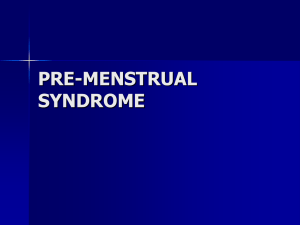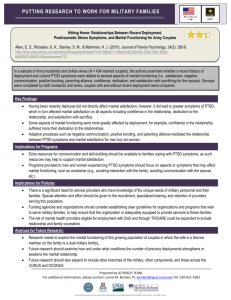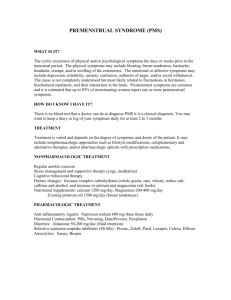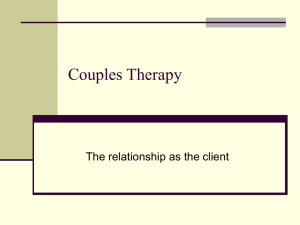Title
advertisement
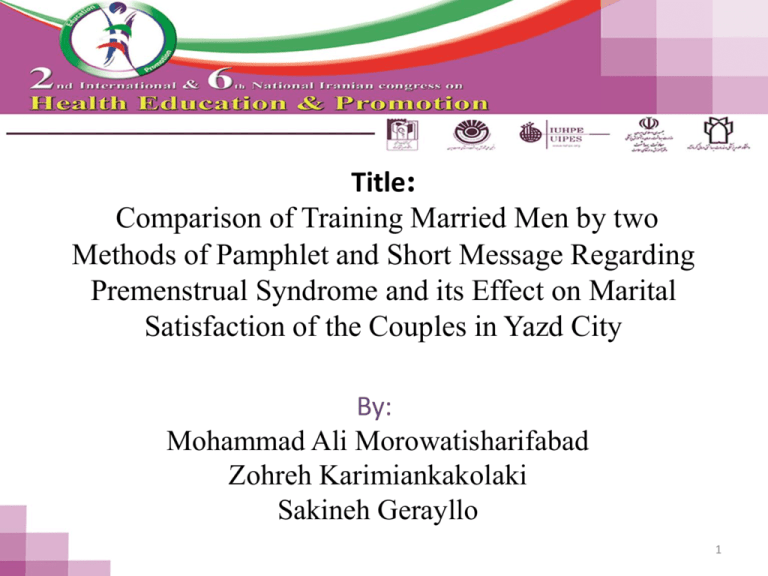
Title: Comparison of Training Married Men by two Methods of Pamphlet and Short Message Regarding Premenstrual Syndrome and its Effect on Marital Satisfaction of the Couples in Yazd City By: Mohammad Ali Morowatisharifabad Zohreh Karimiankakolaki Sakineh Gerayllo 1 Introduction Premenstrual syndrome (PMS) includes physical, psychological and emotional symptoms that occur during the luteal phase of the menstrual cycle and subside with the start of menstruation or during the first days of bleeding. The American College of Obstetricians and Gynecologists (ACOG) reported that 85% of the women of reproductive age have one or more symptoms of PMS. The reported prevalence of PMS in Iranian teenage girls is 30–60%. According to the ACOG, PMS symptoms include anxiety, mood instability, anger, feeling out of control, change in appetite, difficulty sleeping, difficulty concentrating, fatigue, lethargy, chest pain, joint or muscle pain, weight gain, acne, bloating and impaired adaptation. 2 Introduction Hoga et al. conducted a qualitative study to describe the perspectives of 20 women with PMS regarding the behavior of their spouses in face of this event and concluded that men have little information on the impact of this syndrome on women and do not know how to behave even when they want to support their partners. Marital satisfaction can be under the influence of lack of awareness in this regard. Therefore, increasing husbands’ information about reproductive health and additional studies on this target group may assist in recognizing the extent of the issue and the importance of timely treatment and the necessary training in an attempt to alleviate the problems. 3 Study Aim This study was designed and conducted with the aim of Comparing of Training Married Men by two Methods of Pamphlet and Short Message Regarding PMS and its Effect on Marital Satisfaction of the Couples in Yazd City. 4 Methods The study was experimental in nature and included pretest and post-test of the outcome measure. The intervention had two levels: (i) pamphlets and (ii) SMS. we estimated the required number of participants to be 80 couples (80 men and 80 women) or 40 couples per group. The couples were recruited from those who had referred to four health centers (out of 16) in four different regions of Yazd. Originally, 240 couple entered the study. In pre intervention evaluation phase the women completed the Premenstrual Symptoms Screening Tool (PSST); those who had the symptoms of PMS stayed in the study and their husbands completed a researcher-made questionnaire to measure their knowledge of PMS. 5 Methods Both couples completed the Index of Marital Satisfaction (IMS) and the men with the minimum marital satisfaction score (30) were invited to participate in the interventional phase of the investigation. The 80 couples who met the inclusion criteria were randomly assigned to either the pamphlets or SMS groups. We then handed the educational pamphlets to the men in pamphlet training group and obtained cell phone numbers of the men in short messaging group to send them two daily SMS about PMS for 20 days. Three months after the pretest, in post intervention evaluation phase, husbands completed the PMS knowledge and practice questionnaire and both couples completed the IMS questionnaire. 6 Measures The PSST, which was used for screening women with PMS, is a 19-item questionnaire that consists of two sections. The first section consists of 14 questions about mood, physical and behavioral symptoms. The second section contains five questions designed to measure the effects of PMS symptoms on people’s lives. The research team elaborated a two-part questionnaire. The first part included 18 questions about the psychological symptoms of PMS, 18 questions about the physical symptoms of PMS and 15 strategies that may be used to prevent or reduce PMS symptoms. The second part included eight items related to how men deal with PMS and a four-point Likert type scaling was used. The internal consistency, as measured by Cronbach’s Coefficient Alpha, was 0.78. The IMS questionnaire is a 25-point tool The IMS scores of <30 suggest the absence of a significant clinical problem. The split-half reliability is reported to be 0.98. 7 Results Paired samples t-test showed that, pretest to post-test differences of men’s knowledge and practices of PMS and marital satisfaction as well as women’s marital satisfaction were statistically significant.(P<0.05) However, independent samples t-test showed, group differences, both in before and after intervention, were not statistically significant.(P>0.05) 8 Table(1):Group Comparison on Pretest and Posttest Measure of Marital Satisfaction, PMS Knowledge, and PMS Practices group variables men's marital satisfaction women's marital satisfaction men's knowledge men's practice Before After p value Before After p value Before After p value Before After p value pamphlet Short message Test to compare tow group Mean SD Mean SD p value 37.95 9.73 37.25 11.70 0.772 32.15 7.52 33.72 6.63 0.326 0.01> - 0.008 36.88 14.63 35.80 15.69 0.750 32.13 10.47 31.78 10.29 0.880 0.016 - 0.014 28.51 6.96 30.04 6.63 0.318 33.63 4.17 33.44 4.21 0.836 0.01> - 0.002 22.55 4.77 23.20 5.66 0.580 25.00 4.33 26.24 4.46 0.211 0.009 0.01> - 9 Discussion and Conclusions The results of the study showed (i) statistically significant pretest to post-test increases in marital satisfaction in both groups and (ii) no statistically significant differences between the two training methods. The review of the literature showed no studies comparing the effectiveness of pamphlet and SMS in influencing marital satisfaction. However, there are studies which examined the effects of education on marital satisfaction. For example, the results of a research by Hoga et al. indicated that a planned guidance on PMS is necessary to avoid problems and its consequences in individual, familial and social life of the women and couples’ relationships. We found similar results, which suggest that if men are adequately knowledgeable about PMS, they are better prepared to deal with the related problems which may lead to positively affecting marital satisfaction. Most women are critical of men for not understanding the psychological and physical conditions that they experience during the premenstrual period, which in turn results in restlessness, emotional stress, and conflict that lead to quarrel and 10 disruption in marital relationship. Discussion and Conclusions Although everyday stressful life events can negatively influence the quality of the marriage, we found that if adequate training in the forms of either pamphlets or short messages is provided, men may be better prepared to react to the problems associated with PMS, resulting in more favorable environment for marital satisfaction. Studies by Mansouri-nia et al. and Vizheh et al. also showed the usefulness of training in improving marital satisfaction. Thus, it is concluded that correct training has the potential to positively affect marital satisfaction among the couples. There are some studies that examined the effects of pamphlet and SMS separately. For example, Mangli et al reported that educational pamphlets are effective in improving satisfaction among pregnant women. Joo et al. found that SMS is an appropriate method for modifying weight control behavior in an attempt to alleviate obesity. Uhrig et al. showed that if SMS is designed properly, it is effective in reducing risky behaviors among HIV-positive men. 11 Discussion and Conclusions The results showed that the marital satisfaction of the couples increased after the training, and that the men’s awareness and practice, which were low before training, increased after the completion of the intervention. Both the pamphlet and SMS were effective teaching methods, perhaps because all educational programs that meet the need of the target group must be considered effective. However, modern training techniques are always in competition with traditional methods and it may be useful to use both. The replication of the study with other populations is recommended. Providing educational programs before the marriage for young couples is suggested. 12 Thank You 13

